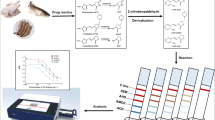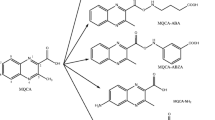Abstract
There is an urgent need for the rapid and simultaneous detection of multiple analytes present in a sample matrix. Here, a multiplex immunochromatographic test (multi-ICT) was developed that successfully allowed for the rapid and simultaneous detection of four major nitrofuran metabolites, i.e., 3-amino-2-oxazolidinone (AOZ), semicarbazide (SEM), 3-amino-5-methylmorpholino-2-oxazolidinone (AMOZ), and 1-aminohydantoin (AHD), in fish samples. Four different antigens were separately immobilized in four test lines on a nitrocellulose membrane. Goat anti-mouse immunoglobulin (IgG) was used as a control. Sensitive and specific monoclonal antibodies (mAbs) that recognize the corresponding antigens were selected for the assay, and no cross-reactivity between the antibodies in the detection assay was observed. The free analytes in samples or standards were pre-incubated with freeze-dried mAb–gold conjugates to improve the sensitivity of the detection assay. The multi-ICT detection was accomplished in less than 15 min by the naked eye. The cutoff values for the strip test were 0.5 ng/mL for AOZ and 0.75 ng/mL for AHD, SEM, and AMOZ, which were all below the maximum residue levels set by the European Union and China. A high degree of consistency was observed between the multi-ICT method and commercially available enzyme-linked immunosorbent assay (ELISA) kits using spiked, incurred, and “blind” fish samples, indicating the accuracy, reproducibility, and reliability of the novel test strip. This newly developed multi-ICT strip assay is suitable for the rapid and high-throughput screening of four nitrofuran metabolites in fish samples on-site, with no treatment or devices required.

A multiplex immunochromatographic test (multi-ICT) was developed that successfully allowed for the rapid and simultaneous detection of four major nitrofuran metabolites (AOZ, SEM, AMOZ, and AHD) in fish samples





Similar content being viewed by others
References
Vervoort J, Xavier BB, Stewardson A, et al. An in vitro deletion in ribE encoding lumazine synthase contributes to nitrofurantoin resistance in Escherichia coli. Antimicrob Agents Chemother. 2014;58(12):7225–33.
Wang Q, Liu YC, Chen YJ, et al. Development of a direct competitive chemiluminescent ELISA for the detection of nitrofurantoin metabolite 1-amino-hydantoin in fish and honey. Anal Methods. 2014;6(12):4414–20.
Zhang Z, Wu Y, Li X, et al. Multi-class method for the determination of nitroimidazoles, nitrofurans, and chloramphenicol in chicken muscle and egg by dispersive-solid phase extraction and ultra-high performance liquid chromatography-tandem mass spectrometry. Food Chem. 2017;217:182–90.
Du NN, Chen MM, Sheng LQ, et al. Determination of nitrofuran metabolites in shrimp by high performance liquid chromatography with fluorescence detection and liquid chromatography-tandem mass spectrometry using a new derivatization reagent. J Chromatogr. 2014;1327(1):90–6.
Kaufmann A, Butcher P, Maden K, et al. Determination of nitrofuran and chloramphenicol residues by high resolution mass spectrometry versus tandem quadrupole mass spectrometry. Anal Chim Acta. 2015;862:41–52.
Zhang Y, Qiao H, Chen C, et al. Determination of nitrofurans metabolites residues in aquatic products by ultra-performance liquid chromatography-tandem mass spectrometry. Food Chem. 2016;192:612–7.
Auro A, Sumano H, Ocampo L, et al. Evaluation of the carcinogenic effects of furazolidone and its metabolites in two fish species. Pharmacogenomics J. 2004;4(1):24–8.
Rodziewicz L, Chromatogr J, Analyt B. Determination of nitrofuran metabolites in milk by liquid chromatography-electrospray ionization tandem mass spectrometry. Technol Biomed Life Sci. 2008;864(1):156–60.
Williams EM, Triller DM. Recurrent acute nitrofurantoin-induced pulmonary toxicity. Pharmacotherapy. 2006;26(5):713–8.
Commission Regulation (EC) 1442/95 amending Annexes I, II, III and IV of Regulation (EEC) No 2377/90 laying down a Community Procedure for the establishment of maximum residue limits of veterinary medicinal products in foodstuffs of animal origin. Off. J. Eur. Commun. 1995; L143, 26–30.
Federal Register. Topical nitrofurans, extralabel animal drug use, and order of prohibition. 2002; 67:5470–71.
Regulation of Department of Agriculture of China. List of banned veterinary drugs and other compounds in food producing animals. 2002; no. 193.
European Commission. Commission Directive 96/23/EC measuring to monitor certain substances and residues thereof in live animals and animal products. Off. J. Eur. Commun. 1996; L125,10.
European Commission. Commission Decision 2002/657/EC implementing Council Directive 96/23/EC concerning the performance of analytical methods and interpretation of results. Off. J. Eur. Commun. 2002; L221, 8.
European Commission. Commission decision 2003/182/EC amending decision 2002/657/EC as regards setting of minimum required performance limits (MRPLs) for certain residues in food of animal origin. Off. J. Eur. Commun. 2003; L71, 17–18.
Xia X, Li X, Zhang S, et al. Simultaneous determination of 5-nitroimidazoles and nitrofurans in pork by high-performance liquid chromatography–tandem mass spectrometry. J Chromatogr A. 2008;1208(1):101–8.
Zhang S, Guo Y, Yan Z, et al. A selective biomarker for confirming nitrofurazone residues in crab and shrimp using ultra-performance liquid chromatography-tandem mass spectrometry. Anal Bioanal Chem. 2015;407(30):8971–7.
Leitner A, Zöllner P, Lindner W. Determination of the metabolites of nitrofuran antibiotics in animal tissue by high-performance liquid chromatography-tandem mass spectrometry. J Chromatogr. 2008;939(1):49–58.
Shendy AH, Al-Ghobashy MA, Gad Alla SA. Development and validation of a modified QuEChERS protocol coupled to LC-MS/MS for simultaneous determination of multi-class antibiotic residues in honey. Food Chem. 2016;190:982–9.
Cooper KM, Samsonova JV, Plumpton L. Enzyme immunoassay for semicarbazide—the nitrofuran metabolite and food contaminant. Anal Chim Acta. 2007;592(1):64–71.
Liu YC, Jiang W, Chen YJ, et al. A novel chemiluminescent ELISA for detecting furaltadone metabolite, 3-amino-5-morpholinomethyl-2-oxazolidone (AMOZ) in fish, egg, honey and shrimp samples. J Immunol Methods. 2013;395(2):29–36.
Jester ELE, Abraham A, Wang Y. Performance evaluation of commercial ELISA kits for screening of furazolidone and furaltadone residues in fish. Food Chem. 2014;145(7):593–8.
Cooper KM, Caddell A, Elliott CT, Kennedy DG. Production and characterisation of polyclonal antibodies to a derivative of 3-amino-2-oxazolidinone, a metabolite of the nitrofuran furazolidone. Anal Chim Acta. 2004;520(1):79–86.
Huang X, Aguilar ZP, Xu H, Lai W, Xiong Y. Membrane-based lateral flow immunochromatographic strip with nanoparticles as reporters for detection: a review. Biosens Bioelectron. 2016;75:166–80.
Guo Y, Ngom B, Le T, Jinet X, Wang L, Shi D, et al. Utilizing three monoclonal antibodies in the development of an immunochromatographic assay for simultaneous detection of sulfamethazine, sulfadiazine, and sulfaquinoxaline residues in egg and chicken muscle. Anal Chem. 2010;82(18):7550–5.
Jia X, Song T, Liu Y, Meng L, Mao X. An immunochromatographic assay for carcinoembryonic antigen on cotton thread using a composite of carbon nanotubes and gold nanoparticles as reporters. Anal Chim Acta. 2017;969:57–62.
Li X, Li PW, Zhang Q, Li R, Zhang W, Zhang Z, et al. Multi-component immunochromatographic assay for simultaneous detection of aflatoxin B1, ochratoxin A and zearalenone in agro-food. Biosens Bioelectron. 2013;49:426–32.
Kong D, Liu L, Song S, Suryoprabowo S, Li A, Wang L, et al. Gold nanoparticle-based semi-quantitative and quantitative ultrasensitive paper sensor for the detection of twenty mycotoxins. Nano. 2016;8(9):5245–53.
Xing C, Liu L, Song S, Feng M, Kuang H, Xu C. Ultrasensitive immunochromatographic assay for the simultaneous detection of five chemicals in drinking water. Biosens Bioelectron. 2015;66:445–53.
Glupczynski Y, Jousset A, Evrard S, Bonnin RA, Huang TD, Dortet L, et al. Prospective evaluation of the OKN K-SeT assay, a new multiplex immunochromatographic test for the rapid detection of OXA-48-like, KPC and NDM carbapenemases. J Antimicrob Chemother. 2017;72(7):1955–60.
Wang W, Su X, Ouyang H, Wang L, Fu Z. A novel immunochromatographic assay based on a time-resolved chemiluminescence strategy for the multiplexed detection of ractopamine and clenbuterol. Anal Chim Acta. 2016;917:79–84.
Jiang W, Liu Y, Chen Y, Yang Q, Chun P, Yao K, et al. A novel dynamic flow immunochromatographic test (DFICT) using gold nanoparticles for the serological detection of Toxoplasma gondii infection in dogs and cats. Biosens Bioelectron. 2015;72:133–9.
Kai M, Wenjing S, Peng Z, et al. Development of colloidal gold-based immunochromatographic assay for rapid detection of Mycoplasma suis in porcine plasma. Biosens Bioelectron. 2014;55:396–9.
Liu Y, Jiang W, Chen Y, Zeng P, Zhang M, Wang Q. Simultaneous detection of four nitrofuran metabolites in honey using high-throughput suspension array technology. Anal Methods. 2015;7(10):4097–103.
Gao AZ, Chen QL, Cheng L, Lei J, Zeng LW. Preparation of monoclonal antibodies against a derivative of semicarbazide as a metabolic target of nitrofurazone. Anal Chim Acta. 2007;592(1):58–63.
Pimpitak U, Putong S, Komolpis K, Petsom A, Palaga T. Development of a monoclonal antibody-based enzyme-linked immunosorbent assay for detection of the furaltadone metabolite, AMOZ, in fortified shrimp samples. Food Chem. 2009;116(3):785–91.
Regulation (EC) 470/2009. Laying down community procedures for the establishment of residue limits of pharmacologically active substances in foodstuffs of animal origin. Off J Eur Commun. 2009;L152:11–22.
Lu X, Liang X, Dong J, Fang Z, Zeng L. Lateral flow biosensor for multiplex detection of nitrofuran metabolites based on functionalized magnetic beads. Anal Bioanal Chem. 2016;408(24):6703–9.
Acknowledgments
We are thankful to Dr. Xiangan Han for expert advice and helping to edit the manuscript.
Funding
This work was funded by the Shanghai Science and Technology Standard Fund (Grant No. 17140900400) and the National Special Research Programs for Non-Profit Trades (Agriculture) (Grant No. 201303045).
Author information
Authors and Affiliations
Corresponding author
Ethics declarations
All animal experiments were in accordance with the Institutional Animal Care and Use Committee (IACUS) guidelines of the Shanghai Veterinary Research Institute at the Chinese Academy of Agricultural Sciences (CAAS). The Ethics Committee of CAAS approves the use of fish for the present experiment.
Conflict of interest
The authors declare that they have no conflict of interest.
Rights and permissions
About this article
Cite this article
Wang, Q., Liu, Y., Wang, M. et al. A multiplex immunochromatographic test using gold nanoparticles for the rapid and simultaneous detection of four nitrofuran metabolites in fish samples. Anal Bioanal Chem 410, 223–233 (2018). https://doi.org/10.1007/s00216-017-0714-y
Received:
Revised:
Accepted:
Published:
Issue Date:
DOI: https://doi.org/10.1007/s00216-017-0714-y




